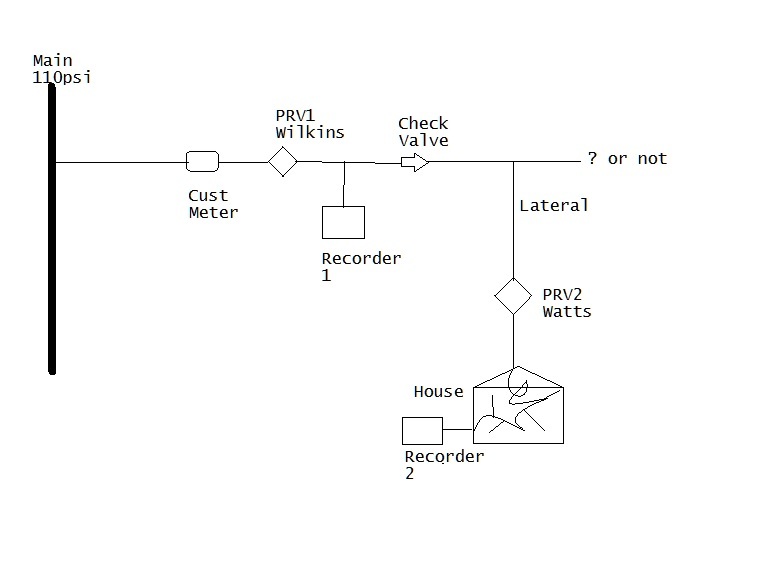I work for a utility and we have been having a long term issue associated with a customer's pressure. The customer has had some leaks, one of which resulted in the loss of a significant amount of water. There are a number of issues, including the customer's internal piping which is a mixture of materials including Qest. We've notified the customer of this and have been working with him - initially trying to provide the information to him to allow him to install and maintain his own PRV properly. Other issues have come up and we've gotten more involved as we are being accused of being the source of the issues. The customer is served by a small diameter line (likely a 1" galvanized line) that we intend to replace as part of our ongoing line replacement program. In the meantime, I have been unable to make sense out of what is happening at this customer location. There 3 other customers on this line, this customer is at the end of the line and is the only one having issues (that we know of).
The description of the set up at this location is as follows:
System (105-110 ave. press.)-->Customer Meter-->PRV1 (Wilkins)-->Tee for Press. Recorder 1-->Check valve (inline ball check)-->Lateral to house-->PRV2 (Watts)-->House plumbing-->Press. Recorder 2
The customer watches his internal gauges constantly and calls whenever the pressure is above 70 psi. We have several charts showing something that I am not able to explain. I have attached one. The pressure routinely climbs above the setpoint of the PRVs. Initially it appears that is could be thermal expansion and we added a check valve to the line in the anticipation that this would provide the data needed to demonstrate this or that something internal to the home is adding energy to the system. However, the data following the installation of the check valve (between the 2 PRVs) shows that they both increased in pressure and continued to track along with each other. The check valve is new and I guess there is a chance that it may not be working properly but it didn't seem probable. We have adjusted the PRVs and they continue to allow pressure to go above the setpoint. As a result, we continued to receive calls. The PRVs are direct acting 3/4" valves - both are relatively new.
To try to keep the pressure from being seen on customer side we also installed a pressure relief valve after the first PRV that would keep the pressure at 65 psi. This worked for a few weeks but we are now seeing that the PRV upstream from the blow off will no longer maintain a pressure setpoint - we make adjustments (while flowing a small volume of water) but as soon as we stop the flow, the pressure climbs over the setpoint and up to the relief valve setpoint (10 psi higher than the PRV setpoint), which will then run/drip almost continuously.
Any thoughts/suggestions on this would be appreciated.
The description of the set up at this location is as follows:
System (105-110 ave. press.)-->Customer Meter-->PRV1 (Wilkins)-->Tee for Press. Recorder 1-->Check valve (inline ball check)-->Lateral to house-->PRV2 (Watts)-->House plumbing-->Press. Recorder 2
The customer watches his internal gauges constantly and calls whenever the pressure is above 70 psi. We have several charts showing something that I am not able to explain. I have attached one. The pressure routinely climbs above the setpoint of the PRVs. Initially it appears that is could be thermal expansion and we added a check valve to the line in the anticipation that this would provide the data needed to demonstrate this or that something internal to the home is adding energy to the system. However, the data following the installation of the check valve (between the 2 PRVs) shows that they both increased in pressure and continued to track along with each other. The check valve is new and I guess there is a chance that it may not be working properly but it didn't seem probable. We have adjusted the PRVs and they continue to allow pressure to go above the setpoint. As a result, we continued to receive calls. The PRVs are direct acting 3/4" valves - both are relatively new.
To try to keep the pressure from being seen on customer side we also installed a pressure relief valve after the first PRV that would keep the pressure at 65 psi. This worked for a few weeks but we are now seeing that the PRV upstream from the blow off will no longer maintain a pressure setpoint - we make adjustments (while flowing a small volume of water) but as soon as we stop the flow, the pressure climbs over the setpoint and up to the relief valve setpoint (10 psi higher than the PRV setpoint), which will then run/drip almost continuously.
Any thoughts/suggestions on this would be appreciated.

